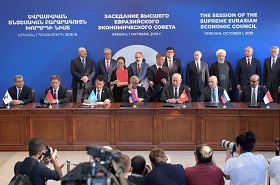The full implementation of the Treaty on the Creation of a Union State of Russia and Belarus signed on December 8, 1999, envisaged the creation of a unique post-Soviet association that would combine the features of an international organization and a state. The idea was for the Union State to resemble the European Union, and even surpass it somewhat in terms of the degree of integration.
Despite all of this, only half of these plans have been implemented over the past 20 years at best. Political integration stalled immediately after the creation of the supranational Council of Ministers, Parliamentary Assembly and Standing Committee, which was expected to be the permanent governing body of the Union State. These international structures are unable to exercise broad powers because a common constitution has yet to be drawn up.
Eventually, the relevance of the Union State could be increased by returning its original ambitions to create a unique international organization in the post-Soviet that would encompass the political, economic, humanitarian and military components. However, a tactical approach will likely prevail amidst chronic uncertainty in international relations. This means that the Union State will continue to exist in more or less the same form as today, with breakthroughs in individual areas of socioeconomic cooperation and periodic crises that the presidents of the two countries will have to resolve on a case-by-case basis.
A Russia–Belarus European Union
The full implementation of the Treaty on the Creation of a Union State of Russia and Belarus signed on December 8, 1999, envisaged the creation of a unique post-Soviet association that would combine the features of an international organization and a state. The idea was for the Union State to resemble the European Union, and even surpass it somewhat in terms of the degree of integration.
The Union State was expected to feature not only a single economic space, but also a common constitution that would form the basis for the creation and functioning of supranational governing bodies such as a union government, parliament and a unified judiciary system. The decisions of these bodies would have the force of law and would be binding for the member nations.
The joint policy was to be implemented with the help of a common supranational budget, which would be created through a joint tax system with a single pricing mechanism, common currency, etc. As a result, a significant share of government functions was to be transferred from the national to the supranational level, with neither Russia nor Belarus losing their sovereignty in the process. They would also retain their subjectivity, including in international relations.
Despite all of this, only half of these plans have been implemented over the past 20 years at best. Political integration stalled immediately after the creation of the supranational Council of Ministers, Parliamentary Assembly and Standing Committee, which was expected to be the permanent governing body of the Union State. These international structures are unable to exercise broad powers because a common constitution has yet to be drawn up.
Economic integration has progressed far more successfully. Even without the single currency, pricing and taxation systems that were originally envisaged, the economies of Russia and Belarus have “merged” in the form of over 2500 joint ventures, 4 billion USD of Russian investments into Belarus, more than 600 million USD of Belarusian investments into Russia, preferential oil and gas supplies and approximately USD 34 billion in mutual trade in 2019.
The most considerable progress has been achieved in security and the social sphere. Russia and Belarus jointly defend the Union State airspace, have set up a common regional air defence system and operate a regional armed force. More than 30 defence cooperation agreements are currently in force between the two countries.
Even more has been done to ensure the equal rights of Russian and Belarusian citizens when applying for jobs, enrolling at universities and crossing the shared border. However, there is still room for improvement in this area. This is most evident in education. For example, Belarusian high school students can write the Russian Unified State Exam and thus gain entry to a Russian university on a full scholarship. However, Russian universities do not accept Belarusian state examination results in their admission criteria. This is because the national curriculums in the two countries differ. Granted, harmonizing humanitarian subjects such as history and literature would prove to be problematic, but doing the same for the exact sciences is entirely possible.
Twenty years on, and we can say that citizens and enterprises in the Union State still do not enjoy complete equality. However, even with the current level of integration, the two countries receive image-boosting, economic and military dividends from their association. Therefore, the main issue in the further development of the Union State is whether these dividends can make up for the costs the sides incur in the process of maintaining the union.
An Audit of Integration Processes
The incompleteness of the Union State’s governing institutions and legal framework means that the contradictions that periodically emerge in Russia–Belarus relations cannot be resolved entirely through the Union State mechanisms and guided by Union State logic. As a result, controversial issues either remain unsettled or get resolved through political compromises at the level of the leaders of the two countries. As the global economic and political situation worsened, especially in the 2010s, the number of problematic areas in the dialogue between Russia and Belarus started to grow. The Ukrainian crisis and the confrontation between Russia and the West proved to be serious catalysts for such contradictions.
These problems have been compounded by the issue of Minsk’s support for Moscow’s foreign policy, the worsening conditions for economic integration, the increasing lack of trust between the Russian and Belarusian elites, the intensified efforts of the West to hinder the development of the Union State, and so on. The growing number of problems that could not be solved through Union State mechanisms came to a head in late 2018, when the presidents of the two countries effectively decided to revise the process of the Union State’s further growth. Special governmental working groups were set up in both countries for this purpose. The result of this work was 31 roadmaps for the further development of the Union State, which will be submitted to the two presidents in late 2019.
Russia views the roadmaps as an instrument for resolving the most challenging problems in bilateral relations, including compensating Belarus for the Russian tax manoeuvre in the oil and gas sector. Minsk believes that the Belarusian budget stands to lose approximately USD 300 million annually as a result. However, the unification of tax legislation envisaged by the roadmaps will allow these costs to be offset and prevent similar problems in the future.
Belarus, for its part, believes that further development of the Union State is only possible after the existing problems have been resolved. In the case of the tax manoeuvre, Belarus thinks it should have received compensation before any roadmaps were signed.
These approaches to the roadmaps are indicative of more fundamental differences between the two countries when it comes to the issue of integration. In the coming years, these differences will play a crucial part in determining the further vector of development of the Union State.
Through Targeted Agreements
The Belarusian approach to the roadmaps demonstrates that, as far as Minsk is concerned, integration processes should be based first of all on economic considerations: minimizing costs, expanding export opportunities, attracting new loans, etc. All other measures to deepen integration are merely derivatives of Belarus's economic needs. This logic implies that political superstructures and humanitarian projects as part of the Union State may well be abandoned entirely if they do not contribute to the development of economic cooperation.
Russia prefers a more comprehensive approach. It is not especially interested in the economic aspect of relations, if only for the fact that Russia’s share in Belarus’ foreign trade is approximately 50 per cent, while Belarus’ share in Russia’s foreign trade amounts to about 5 per cent. What is more, the Ukraine situation demonstrates that economic preferences alone do not automatically imply humanitarian and political proximity, nor do they provide protection against the gradual gestation of anti-Russian sentiment within society and the elite. This is why Moscow, in its Union State talks with Minsk, insists on a more systemic approach that would provide safeguards against disintegration in different aspects of cooperation.
The fact that the two countries failed to sign the complete package of documents on the further development of the Union State on December 8, 2019, indicates the fairly deep contradictions in their approaches to further integration, meaning that we are unlikely to see any breakthroughs in this area in the coming years. The Union State will undoubtedly continue to evolve, but not along the lines of the EU model, with its powerful bureaucratic superstructure and massive delegation of government functions to the supranational level.
As the current uncertainty in international relations continues, Russia and Belarus will most likely further economic cooperation above all, with safeguards in the form of legislative harmonization in individual aspects of cooperation. This path of targeted agreements on the most pressing aspects of interaction has more in common with the erstwhile Council for Mutual Economic Assistance than it does with the European Union. Without powerful supranational institutions, the Union State will go the way of horizontal integration, with the gradual harmonization of new aspects of life in Russia and Belarus.
In the long run, however, this approach may lead to the functions of the Union State being delegated to the Eurasian Economic Union (EAEU) and the Collective Security Treaty Organization (CSTO). In fact, the EAEU is already seizing the initiative from the Union State not only in terms of economic issues (such as forming a uniform industrial policy, resolving disputes related to the free movement of goods and abolishing roaming charges), but also with regard to a number of humanitarian issues (the introduction of a uniform EAEU entry visa, a standard pension system for the five EAEU member states and so on). In addition, the EAEU has become a subject of international law, signing preferential trade agreements with Iran, Vietnam, China, Singapore and Serbia. Moldova has joined the EAEU as an observer state, and the governments of Uzbekistan and Tajikistan are considering the possibility of joining. If the Eurasian Economic Commission is successful in having its powers and controlling functions expanded, then the demand for the Union State formats may shrink further.
Eventually, the relevance of the Union State could be increased by returning its original ambitions to create a unique international organization in the post-Soviet that would encompass the political, economic, humanitarian and military components. However, a tactical approach will likely prevail amidst chronic uncertainty in international relations. This means that the Union State will continue to exist in more or less the same form as today, with breakthroughs in individual areas of socioeconomic cooperation and periodic crises that the presidents of the two countries will have to resolve on a case-by-case basis.







